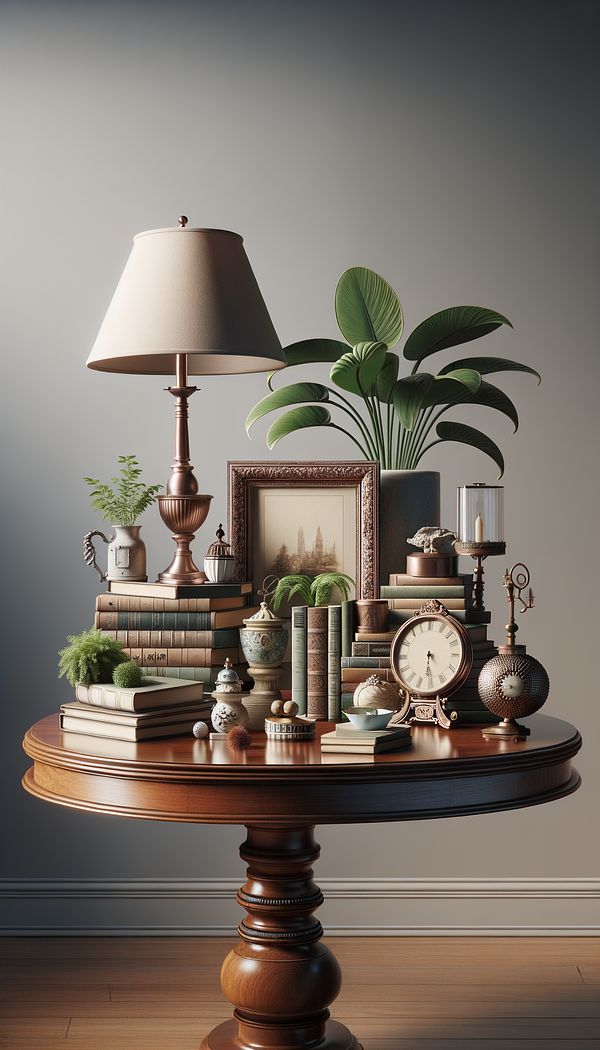What is a Vignette?
A vignette in interior design is a carefully curated display of objects that tell a story or evoke a particular mood.
Description
In interior design, a vignette is more than just a random assortment of objects placed together. It is a thoughtfully arranged scene or composition that reflects the homeowner's personal style, interests, and the overall aesthetic of the space. Vignettes are used to draw the eye and add interest to a room, often creating focal points that invite exploration and contemplation.
Creating a vignette involves selecting a variety of elements such as decorative objects, art and sculpture, textiles and upholstery, or lighting [[fixtures and hardware]]. The arrangement is typically done on surfaces like tables, shelves, or mantelpieces. The key is to balance the items in terms of size, texture, and color to achieve harmony and coherence. Vignettes can be themed around seasons, holidays, personal milestones, or any subject that resonates with the individual or space.
Besides aesthetics, vignettes can also serve practical purposes. They can be used to organize collections, display cherished memorabilia, or simply to fill an empty space with interest and personality. The versatility of vignettes means they can be adapted to any design style, from minimalism to maximalism, making them a popular decorative technique in a wide range of interior design projects.
Usage
An example of a vignette might be a reading nook featuring a comfortable chair, a small table with a lamp, a stack of favorite books, and a vase of fresh flowers. Another example could be a mantle decorated with framed family photos, heirloom objects, and candles to create a warm and inviting atmosphere.
FAQs
-
How do you create a vignette?
Creating a vignette involves selecting a cohesive collection of items that reflect a personal theme or story, and arranging them purposefully on a surface like a shelf, table, or mantelpiece, keeping balance and harmony in mind.
-
Can vignettes be changed often?
Yes, vignettes are highly versatile and can be easily updated or changed to reflect seasons, holidays, or personal preferences. This flexibility allows for continuous personalization of a space.
-
Are there any rules for creating a vignette?
While there are no strict rules, some guidelines can help create an effective vignette, such as using objects of varying heights, incorporating texture and color, and considering the balance and focal point of the display.
Practical Application
To create your own vignette, start by choosing a surface, then select a few items that tell your story or evoke the mood you're aiming for. Consider using items with different heights and textures to add dimension. Don't forget the importance of lighting, which can enhance the overall effect of the vignette. Play around with the arrangement until you find a balance that feels right. Remember, the goal is to create a scene that reflects your personality and complements your space.
-
Decorative Techniques322 articles
-
Decorative Objects240 articles
-
Art & Sculpture30 articles
-
Lighting Fixtures & Hardware17 articles
-
Textiles & Upholstery252 articles
-
Slipper ChairA slipper chair is an armless, upholstered chair with short legs, originally designed for Victorian-era bedrooms.
-
Bishop’s SleeveA type of curtain design that resembles the flowing sleeves of a bishop's robe.
-
HyggeHygge is a Danish and Norwegian word for a mood of coziness and comfortable conviviality with feelings of wellness and contentment.
-
GothicGothic refers to a style that is characterized by intricate designs, pointed arches, and a heavy emphasis on verticality and light.
-
Crest RailA crest rail is the uppermost part of a chair's back, often decorative and providing structural support.
